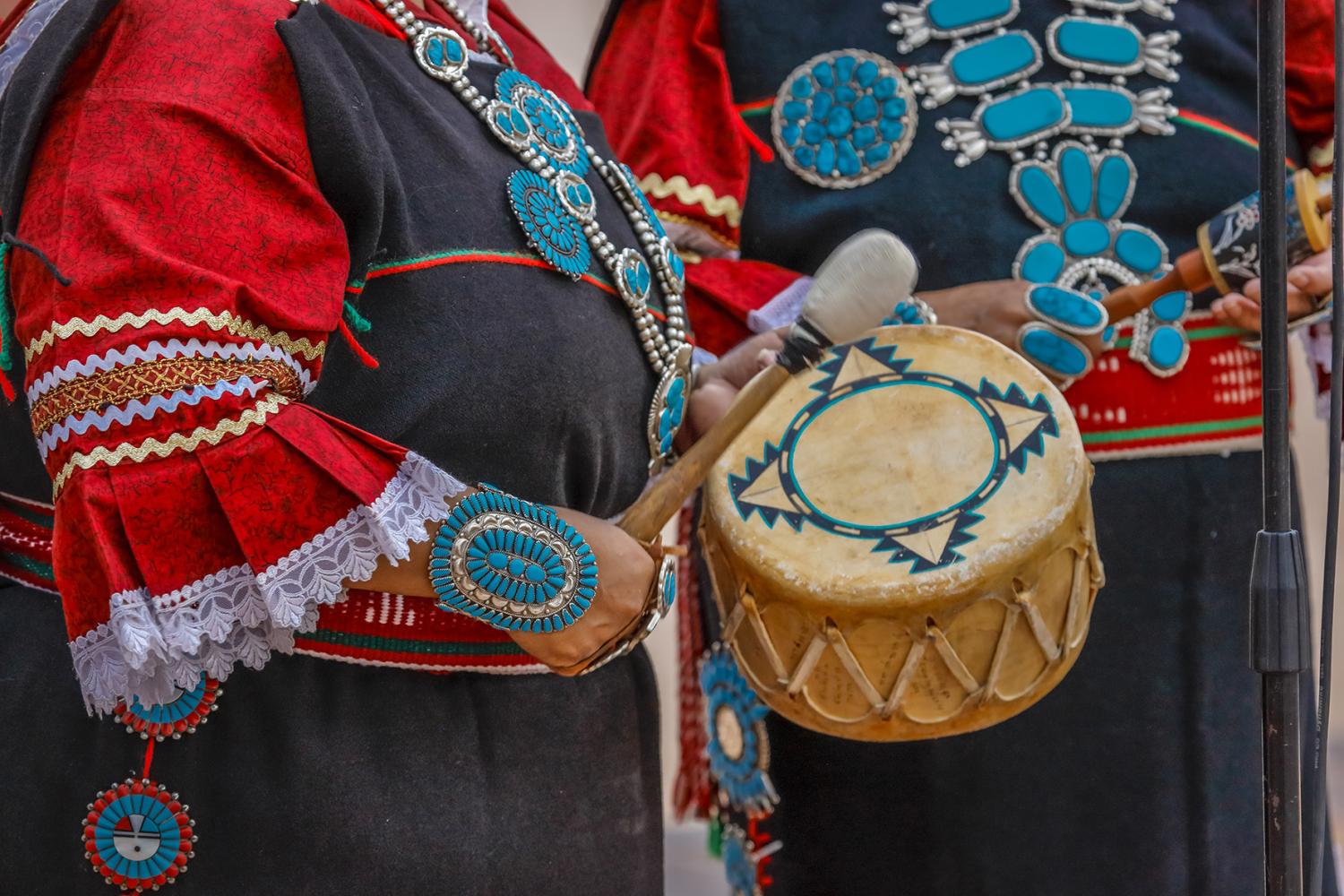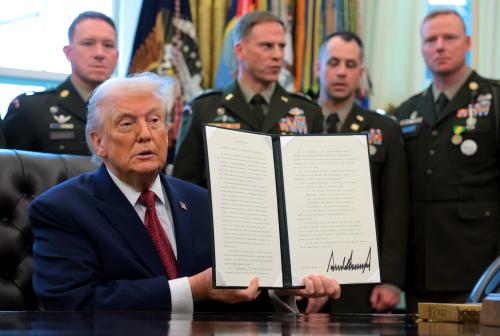Just days into his second term, President Trump’s Office of Management and Budget (OMB) issued a directive to freeze all federal grants, temporarily halting access to trillions in funding for states, Native American Tribal governments, municipalities, nonprofit organizations, and other entities in the United States and around the world. While the initial order was rescinded within days, the administration has continued its legal efforts to ensure it could enact a government-wide funding freeze in the future. In the coming months, a federal appeals court will hear arguments for the case New York v. Trump, which will decide whether the executive branch has the legal authority to unilaterally suspend federal grants en masse.
This brief explores what’s at stake for Native American Tribes and people when the federal government stymies grant funding. Distinct from other populations in the country, Tribes have a government-to-government relationship with the United States, which maintains trust and treaty obligations that require it to meet the economic and social needs of Tribes and Native American people. As such, when the federal government withholds funding from Tribes and Native American people, it’s not just a policy change. It’s a violation of those commitments—putting essential services at risk and undermining Tribal governing capacity.
This piece does not assess the impact of the recently passed One Big Beautiful Bill Act, which implemented many of the Trump administration’s budget priorities and further affected funding for Tribes and Native Americans. Our future research will aim to explore the impact of that policy on Native American communities.
The impact of a federal grant freeze on Native American people
The federal government’s legal obligations to Native Americans are well-established. For nearly two hundred years, the Supreme Court has consistently reaffirmed the legal and moral responsibilities of the government to the interests and welfare of Native people through the protection of their land, natural resources, and access to federal services commensurate with the rest of the United States.
Federal services which the United States provides for Indians are frequently viewed as a matter of charity. The erroneous notion is widely prevalent that in their relationship with the Federal Government, the Indians have been the regular recipients of unearned bounties. In reality, federal services were, in earlier years, largely a matter of self-protection for the white man or partial compensation to the Indian for land cessions or other benefits received by the United States. In recent years such services have been continued, partly as a result of the failure of the states to render certain essential public services to the Indians, because of their special relation to the Federal Government.
United States Department of the Interior, Handbook of Federal Indian Law (1948)
With these obligations in mind, the Trump administration’s effort to withhold disbursement of federal funding is particularly concerning. While some departments and agencies do provide direct service programming to Tribes and Tribal communities, nearly $93 billion in federal investment towards Tribal entities over the past seven years has come from grants and cooperative agreements, making these types of programs the federal government’s primary vehicle for upholding trust and treaty obligations.1 Our analysis finds that of this total, more than $24.5 billion would become temporarily or permanently inaccessible to Tribes if a funding freeze on the scale of OMB’s order were to go into effect.
The impact of this funding freeze would be enormously consequential for Native people living both on and off reservations. Since 2018, the federal government has obligated funding to over 1,700 Tribal governments, Native nonprofits, and Native-owned businesses spanning almost every state in the country.2 These grants and cooperative agreements were distributed by nearly a hundred federal agencies and spanned over 750 programs. Such grants and cooperative agreements range widely in size and scope, and fund a broad array of functions necessary for Tribal government operations, resource management, and Native American well-being. Among the largest grant programs that would be affected by a funding freeze are self-governance grants from the Bureau of Indian Affairs, self-determination grants from the Indian Health Service, and well-known social welfare programs that serve both Native and non-Native people (such as Head Start, Temporary Assistance for Needy Families, and Child Care and Development Block Grants).
If funding were to be frozen, critical projects across the country would be at risk, including a $35 million grant to a Tribe in the Midwest for broadband deployment, a $3 million grant to an urban Native health board for community health worker training, and a $200,000 grant to a Tribe in the Southeast for preliminary engineering and environmental work towards a childcare center.
Nearly all Tribes would be affected by a federal grant freeze, with many facing the prospect of losing tens or even hundreds of millions of dollars—funding that is critical for supporting some of the most historically underserved communities in the United States. The areas most affected by the potential funding freeze closely align with the population centers of Indian Country, including the western Great Plains, Oklahoma, the Southwest, the West Coast, and Alaska. However, in total the funding freeze would directly affect grants serving Tribes and Native people in 46 states and the District of Columbia, as well as 184 out of 435 Congressional districts, and may also have downstream effects in additional states and districts. This serves as an important reminder that Native people are broadly distributed across the country, and that cutting funding to Native Americans would disrupt communities of all sizes across the nation.
A funding freeze would violate federal obligations to Native Americans
The broad geographic and programmatic scope of Native-serving programs indicates that OMB’s grant freeze would severely curtail the federal government’s compliance with legally mandated trust and treaty obligations. These grants go far beyond the confines of Native-specific agencies and set asides; they encompass a significant portion of the “economic and social programs” that, as noted in the Senate’s 1977 American Indian Policy Committee Report, “raise the standard of living and social well-being of the Indian people to a level comparable to the non-Indian society.”
There is little reason to so restrict the trust doctrine other than administrative convenience. There is legal authority that the United States trust duty is much broader. The purpose behind the trust is and always has been to insure the survival and welfare of Indian tribes and people. This includes an obligation to provide those services required to protect and enhance Indian lands, resources, and self-government, and also includes those economic and social programs which are necessary to raise the standard of living and social well-bring of the Indian people to a level comparable to the non-Indian society.
United States Senate, American Indian Policy Committee Report (1977)
In subsequent statements, the White House and OMB have attempted to clarify that it did not interpret this freeze as impoundment (which is explicitly forbidden by Congress), but rather a “temporary pause” in funding. The White House has additionally sought to clarify that not all grant programs are at risk—only programs that violate the Trump administration’s preceding executive orders, including “Protecting the American People Against Invasion,” “Ending Radical and Wasteful Government DEI Programs and Preferencing,” and “Unleashing American Energy.”
Despite this, a May survey of Tribes conducted by the Native American Fish and Wildlife Society found that even as the OMB funding freeze memo was rescinded, 60% of Tribes were experiencing funding freezes, and over a quarter had experienced a grant cancellation. Another recent analysis of grant cancellations data from the Department of Governmental Efficiency (DOGE) determined that nearly a third of all cancelled grant programs contain the word “Tribal,” making it the single most-commonly flagged keyword in the database. The data, therefore, suggest that programs serving Native people and communities are not being exempted from the termination of grants and programs that conflict with the Trump administration’s policies on climate, education, and racial equity.
As litigation around OMB’s funding freeze continues, it is essential that federal decisionmakers recognize the unique basis of funding for Tribes and Native American people. Funding to Indian Country is rooted in longstanding, legally-binding agreements between the United States and sovereign Tribal nations—not race, climate, or DEI. Efforts to freeze or cancel funding to Native American people should be recognized as a violation of these agreements, and considered dangerously detrimental to the government-to-government relationship between Tribes and the United States government.
-
Footnotes
- Brookings analysis of USASpending Data and program descriptions from OMB’s FY2025 Native American Funding Crosscut.
- This analysis uses FY2018 as the base year of analysis in alignment with SAM.gov’s program listing archival period.
The Brookings Institution is committed to quality, independence, and impact.
We are supported by a diverse array of funders. In line with our values and policies, each Brookings publication represents the sole views of its author(s).




